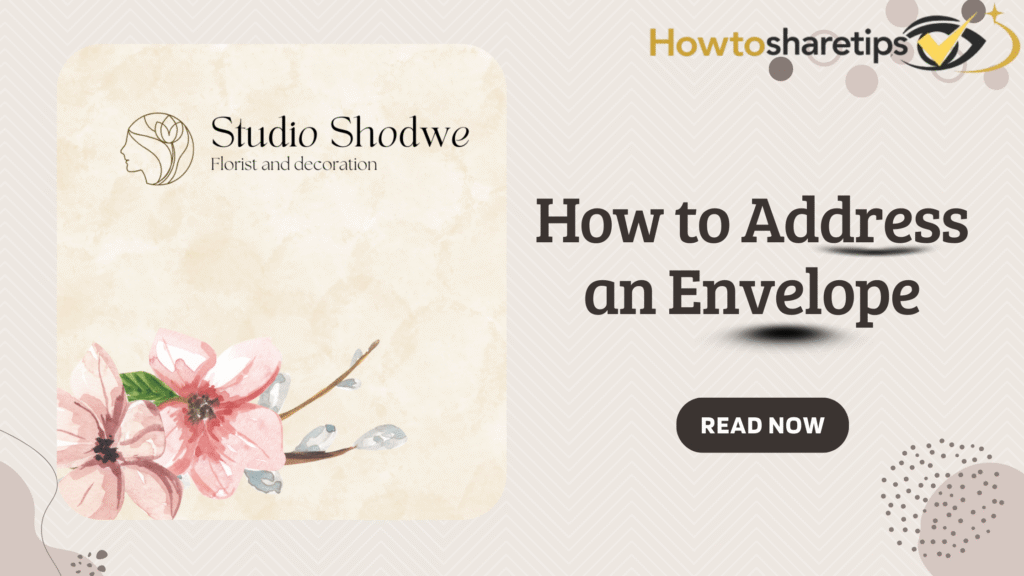Addressing an envelope may seem like a small task, yet it plays a major role in ensuring that your letter or package arrives safely and on time. Whether you are a student sending scholarship applications, a professional mailing official documents, or someone posting a personal letter abroad, learning the correct way to address an envelope is an essential communication skill.
This guide explains the basic rules of envelope addressing, provides examples for personal, business, and international mail, and shares practical study-friendly tips that help students and professionals manage correspondence without stress.
Why Correctly Addressing an Envelope Matters
Every day, students and professionals worldwide lose valuable time and money because of misplaced or delayed letters. Incorrect addressing can lead to lost opportunities, especially when sending admission forms, job applications, or exam scripts. By mastering this skill, you not only improve your communication but also practice attention to detail, a valuable study habit that boosts productivity in both academic and daily life.

The Four Basic Elements of an Envelope
To ensure smooth delivery, always include these four main elements on an envelope:
1. The Sender’s Address
Your name and return address go in the top left corner. This includes:
- Full name
- Street address or PO Box
- City, state, and ZIP code
- Country (for international mail)
Having a sender’s address ensures that undelivered mail returns safely.
2. The Recipient’s Address
Place the recipient’s details at the center of the envelope. Always include:
- Full name and title
- Street address or PO Box
- City, state, and ZIP code
- Country (if international)
Accuracy here prevents delivery delays.
3. Postage Stamp
Attach your stamp in the top right corner. Ensure the stamp matches the size, weight, and destination of your letter. Students applying abroad should confirm international rates to avoid rejection.
4. Return Address (Optional but Recommended)
Often placed on the back flap, this ensures the mail comes back to you if undeliverable. Using a printed label saves time for students managing multiple correspondences.
How to Address Envelopes for Different Purposes
Personal Letters
When writing to friends or family, use a casual format. Abbreviations are acceptable, and titles are optional. Example:
John Smith
123 Main St Apt 4
Springfield IL 62701
Business Correspondence
A professional letter requires a formal tone. Always write full names, job titles, and avoid abbreviations. Example:
Mr. James Lee
Director of Marketing
ABC Inc.
789 Park Avenue
New York, NY 10022
United States of America
Invitations and Formal Events
For weddings, graduations, or conferences, use polite wording and avoid abbreviations. Example:
Mr. and Mrs. John Waters
345 Oak Lane
Boston MA 02115
Study-Friendly Daily Tips for Writing and Mailing
- Practice Writing Clearly: Neat handwriting improves communication and reduces mailing errors.
- Apply Time Management: Allocate specific study hours for correspondence like scholarship or admission applications.
- Use Digital Tools: Students can track international postage rates online before mailing documents.
- Keep Records: Maintain a notebook of recipient addresses for repeat correspondence, just like you do for study notes.
- Learn Global Etiquette: In some countries, postal formats differ. Research before sending academic or business mail internationally.
Tips and Tricks for Addressing an Envelope
To improve your envelope addressing skills, follow these simple yet effective tips:
1. Use Clear and Legible Handwriting or Font
Write neatly using black or blue ink on white or light-colored envelopes. Avoid cursive or overly fancy fonts that may confuse postal workers. If you prefer printing, use labels or stickers, but ensure they are properly aligned and firmly attached.
2. Double-Check Spelling and Punctuation
Always confirm the correct spelling of names, streets, and cities. Use appropriate punctuation, such as commas between address elements and periods for abbreviations. For ZIP or postal codes, hyphens can be added where necessary (e.g., 12345-6789).
3. Verify the Address and ZIP Code
Ensure that the recipient’s address and ZIP code are accurate and current. Online tools and official postal databases can help you confirm details, reducing the risk of misdelivery.
4. Choose the Right Envelope Size and Type
Select an envelope that fits your letter or card properly. Standard envelopes work for most letters, while special envelopes are best for invitations, announcements, or greeting cards. For fragile or bulky items, opt for padded envelopes or mailing boxes.
5. Use the Correct Postage
Weigh and measure your envelope to determine the required postage. You can calculate postage online or at the post office. Make sure you use the right type and amount of stamps to avoid delays. For convenience, postage meters or printers can also be used.
Conclusion
Addressing an envelope may seem like a small detail, but it plays a big role in ensuring smooth and prompt delivery. By following these rules and best practices, your mail will reach the right person at the right time, and your professionalism will shine through.



